| Fig.
5-1 |
Calibration
concept for SCIAMACHY. The final calibrated
Earth radiance spectra are obtained by applying several
calibration steps to the measured Earthshine signals.
They include in-flight calibration measurements (red), onground
measurements performed under thermal vacuum
conditions (green) and component measurements from onground
ambient tests (blue). The optical performance monitoring
(red) provides additional corrections. (graphics: SRON) |
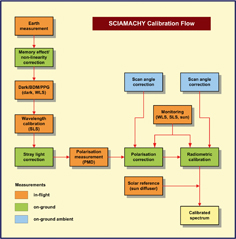
|
| Fig. 5-2 |
Memory
effect for channel 3. Yellow crosses mark the in-flight
measurement of the Memory effect. The blue solid line is a spline fit
through the measurements that is used for the correction. (graphics:
SRON) |
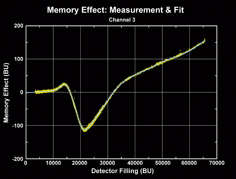
|
| Fig. 5-3 |
Non-Linearity
in channel 8 for different pixel regions (indicated
by colours). ‘Low’ pixels are those with pixel numbers below
512. The
pixel numbering starts at 0. (graphics: SRON) |
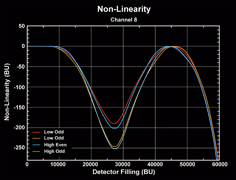
|
| Fig. 5-4 |
q
(blue) and u (red) sensitivity from equ. 5-6 for nadir (elevation
angle of 61° top) and for limb (elevation angle of 11.4° and azimuth angle
of 39°, bottom) for channels 1-5. Note that these sensitivities are multiplied
with the polarisation fractions to get cpol and the correction will thus be
smaller than displayed for lower polarisation. (graphics: SRON) |

|
| Fig. 5-5 |
Definition
of the coordinate frame used in the data processor for polarisation values q = Q/I, u = U/I.
(graphics: DLR-IMF) |
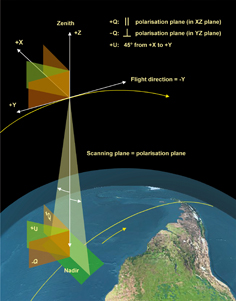
|
| Fig. 5-6 |
Schematic
view of SCIAMACHY light paths used in performance monitoring. (graphics: IUP-IFE, University
of Bremen) |

|
| Fig. 5-7 |
Monitoring
results for the nadir light path using measurements with the
internal WLS in channel 2. All available data have been interpolated to a daily grid.
(graphics: IUP-IFE, University of Bremen) |

|
| Fig. 5-8 |
As
fig. 5-7, but results for channel 4. (graphics: IUP-IFE, University of
Bremen) |
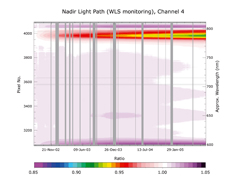
|